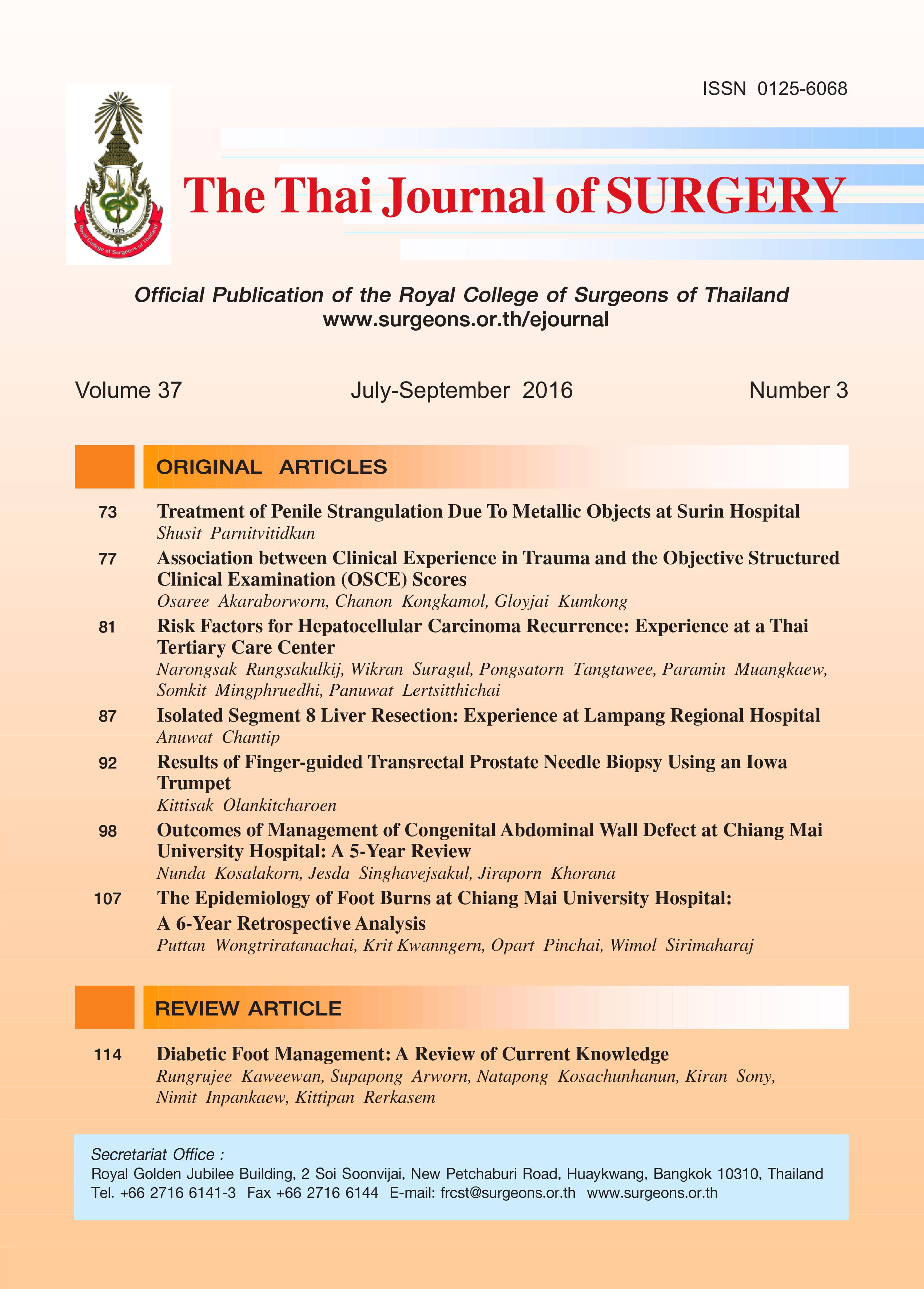The Epidemiology of Foot Burns at Chiang Mai University Hospital: A 6-Year Retrospective Analysis
Keywords:
Foot burn, epidemiology, amputation, risk factorAbstract
The epidemiology of isolated foot burns and foot burns with multifocal areas was evaluated. A total of 114
patients with 174 diagnosed foot burns who were treated in the burn unit of Chiang Mai University Hospital between
January 2007 and December 2012 were retrospectively reviewed. Two-thirds of patients were referred cases. Ninetyfour
patients (83 %) were male, and 20 patients (17%) were female. Thirty-five patients (31 %) were children. The
etiology of the burns was flame injury in 40 % of patients, scalding in 22%, electrical in 3 %, blast injury in 12%, and
contact burns in 4%. Scalding was the most common cause of burns in children (57 %). Anatomic and specific
locations, extent and depth of burn, and modality of treatment were recorded. Conservative wound dressings,
appropriate splinting, and rehabilitation were used for superficial and deep dermal foot burns. Autografting was
applied to 23 % of patients. One locoregional flap was created for coverage. Fourteen patients underwent
amputations of various types. Electrical injury, a common occurrence with electricians, resulted in significantly more
amputations than those without electrical injury (p < 0.001). Third and fourth degree burns were associated with a
higher risk of amputation (p = 0.004). Although the foot accounts for a small percentage of the body surface area,
foot burns is a catastrophic influence on patients’ quality of life.
References
J Burn Care Rehabil 1987;8:192-4.
2. Hemington-Gorse S, Pellard S, Wilson-Jones N, Potokar T.
Foot burns: epidemiology and management. Burns
2007;33:1041-5.
3. Thorne CH, Beasley RW, Aston SJ, Bartlett SP, Gurtner GC,
Spear SL, editors. Grabb and Smith’s Plastic Surgery. 6th ed.
Philadelphia: Lippincott Williams & Wilkins; 2007.
4. Schoen NS, Gottlieb LJ, Zachary LS. Distribution of pedal
burns by source and depth. J Foot Ankle Surg 1996;35:194-
8.
5. Shakirov BM, Tursunov BS. Treatment of severe foot burns in
children. Burns 2005;31:901-5.
6. Shakirov BM. Deep foot burns: effects of early excision and
grafting. Burns 2011;37:1435-8.
7. Kimball Z, Patil S, Mansour H, et al. Clinical outcomes of
isolated lower extremity or foot burns in diabetic versus nondiabetic
patients: a 10-year retrospective analysis. Burns
2013;39:279-84.
8. Barret JP, Herndon DN. Plantar burns in children:
epidemiology and sequelae. Ann Plast Surg 2004;53:462-4.
9. Shakirov BM. Treatment of sandal burns of the feet in children
in a moist environment. J Burn Care Rehabil 2014;40:520-4.
10. Shakirov BM. Sandal burns and their treatment in children. J
Burn Care Rehabil 2004;25:501-5.
11. Chai J, Song H, Sheng Z, et al. Repair and reconstruction of
massively damaged burn wounds. Burns 2003;29:726-32.
12. Mozafari N, Moosavizadeh SM, Rasti M. The distally based
neurocutaneous sural flap: a good choice for reconstruction
of soft tissue defects of lower leg, foot and ankle due to
fourth degree burn injury. Burns 2008;34:406-11.
13. Baumeister S, Koller M, Dragu A, Germann G, Sauerbier M.
Principles of microvascular reconstruction in burn and
electrical burn injuries. Burns 2005;31:92-98.
14. De Lorenzi F, van der Hulst R, Boeckx W. Free flaps in burn
reconstruction. Burns 2001;27:603-12.
Downloads
Published
How to Cite
Issue
Section
License
Articles must be contributed solely to The Thai Journal of Surgery and when published become the property of the Royal College of Surgeons of Thailand. The Royal College of Surgeons of Thailand reserves copyright on all published materials and such materials may not be reproduced in any form without the written permission.



